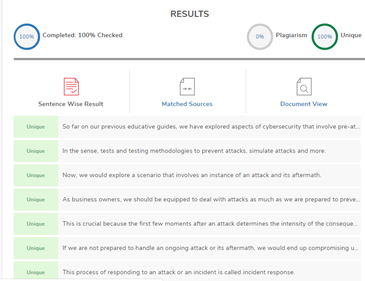Incident Response
So far on our previous educative guides, we have explored aspects of cybersecurity that involve pre-attacks. In the sense, tests and testing methodologies to prevent attacks, simulate attacks and more. Now, we would explore a scenario that involves an instance of an attack and its aftermath.
As business owners, we should be equipped to deal with attacks as much as we are prepared to prevent them. This is crucial because the first few moments after an attack determines the intensity of the consequences and proves if the breach could be contained and removed. If we are not prepared to handle an ongoing attack or its aftermath, we would end up compromising user data, trust and other intangible entities we considered assets.
This process of responding to an attack or an incident is called the incident response. When an attack happens, some of the most confidential elements like intellectual properties, user profiles and their personal data, brand value or business resources and time are compromised. One of the primary purposes of incident response is to curtail the impact of the damages as quickly as possible.
Companies today are prone to more threats than ever. Hackers around the world are coming up with newer ways to gain access to servers, applications and other resources to extract whatever they perceive valuable. In such cases, it’s on us to formulate the best investigative strategies and response plans to protect our company, clients and stakeholders.
How Important Is An Incident Response Plan?
An incident response plan is a company’s first defence mechanism. To explain things better, incident response plans are the lymph nodes of our organizations. The more swollen the plans are, the harder they fight against infections, injections and attacks.
If your incident response plan is poor or if you don’t have one at all, it could alienate your customers from your brand, lose the trust and funding of investors and even spark legal complications. To understand how important incident plans are, realize that in 2013, Target made it significantly difficult for itself to recover from cyber attacks after failing to come up with effective internal safety and security infrastructure even after repeated failures.
Your incident response is critical for your brand and its reputation in the market.
How Does Incident Response Work?
Incident response is a solid framework that deploys a systematic approach into tackling an attack. As suggested by the SANS Institute, there are six steps in an incident response plan.
Preparation
This is the phase where procedures and policies are formulated to follow in the event of a security breach. This determines who will be part of the incident response team and the respective alerts that have to be sent out to internal stakeholders.
Identification
This phase identifies a breach and triggers a very specific response. This is the time when the IT security and infrastructure team members identify the breach with the help of firewalls, intrusion detection tools, threat intelligence streams and more. Threat intelligence is a vital part of this as its associates keep a consistent track of the current trends in attacks and intrusions so your company is always a step ahead in outsmarting your potential attackers.
Containment
Once the breach is identified, it has to be contained so the damages are kept at minimal levels. This containment also prevents further penetrations and intrusions. In this phase, it’s a standard that your company remains in a state of emergency until the breach is completely contained.
Eradication
This is the normalizing phase, where the threats are neutralized and internal systems and infrastructures are restored to their previously functioning states. The eradication phase also involves consistent monitoring of the network or the product for subsequent attacks and intrusions.
Recovery
This is the validation phase where all the compromised systems are checked if they be rolled back to their working conditions. In this stage, three aspects of recovery are executed:
 Determining the timelines within which operations could be restored
Determining the timelines within which operations could be restored Monitoring of the network or products for abnormal activities
Monitoring of the network or products for abnormal activities Estimating the cost of the damage and breach
Estimating the cost of the damage and breach
Takeaway
A lot of companies we have personally worked with usually assume that their job is done with the recovery phase. However, it’s this stage that’s all the more crucial. This is the time the company and its team members realize the lesson learnt and the takeaway from the entire episode. It is now that the policies and procedures are amended keeping in mind the recent attacks, efforts and strategies are optimized, specific decisions are noted down and an executive report is prepared for future references and training.
Our Role
Incident response is a niche specialization that involves technical expertise, domain expertise and years of tracking of breaches and manuals. Over the years, we have been specializing in delivering incident responses to our clients keeping these six steps as the benchmarks. Over these steps, we also add another layer of optimized response plans that stem from our personal experiences with companies.
As no two attacks are the same, our experience over the years has allowed us to detect patterns and identify unique approaches attackers take to enter into systems and networks. That’s why we are prominent for not just preventing attacks but handling them as well.
Get in touch with us today if you intend to have a solid incident response plan in place for the smooth operation of your business even during the most critical times.


